ACC00716 S1 2019: DuoLever Limited Financial Case Study Report
VerifiedAdded on 2023/03/17
|8
|1456
|86
Report
AI Summary
This report presents a financial analysis of two investment options for DuoLever Limited, a company in the personal care industry. The analysis evaluates the feasibility of starting new production versus licensing a patented method, considering both financial and non-financial aspects. The methods used include yearly cash flow analysis and net present value (NPV) calculations. The report includes a memo to the Chief Financial Officer summarizing the findings, which favor licensing the patented method due to higher cash flows and a greater NPV. The analysis considers assumptions about sales revenue, costs, depreciation, and tax rates. It also suggests follow-up measures to mitigate risks associated with the chosen option. The report provides detailed yearly cash flow and NPV calculations, supporting the recommendation for DuoLever Limited to choose the second option for increased profit margin.
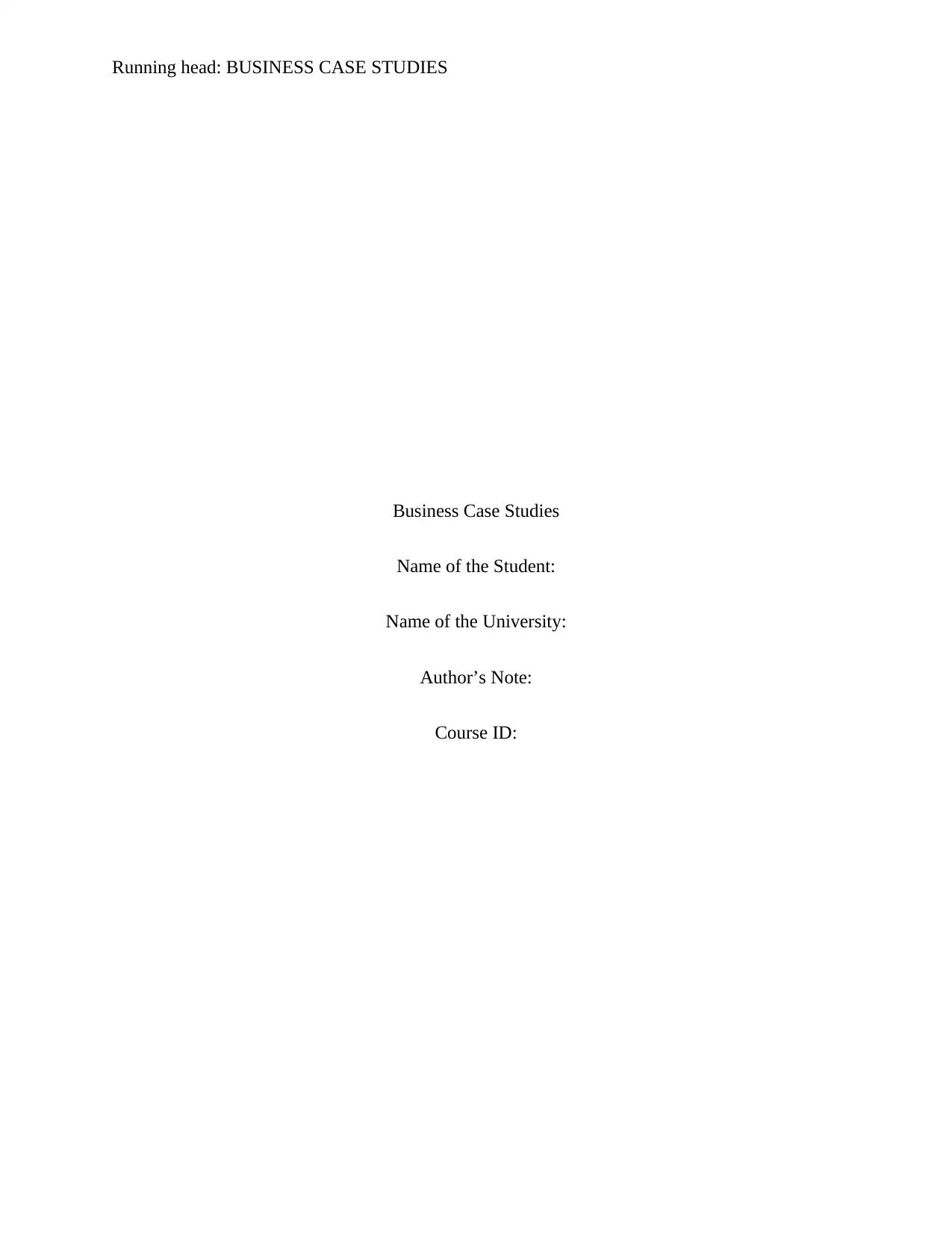
Running head: BUSINESS CASE STUDIES
Business Case Studies
Name of the Student:
Name of the University:
Author’s Note:
Course ID:
Business Case Studies
Name of the Student:
Name of the University:
Author’s Note:
Course ID:
Paraphrase This Document
Need a fresh take? Get an instant paraphrase of this document with our AI Paraphraser
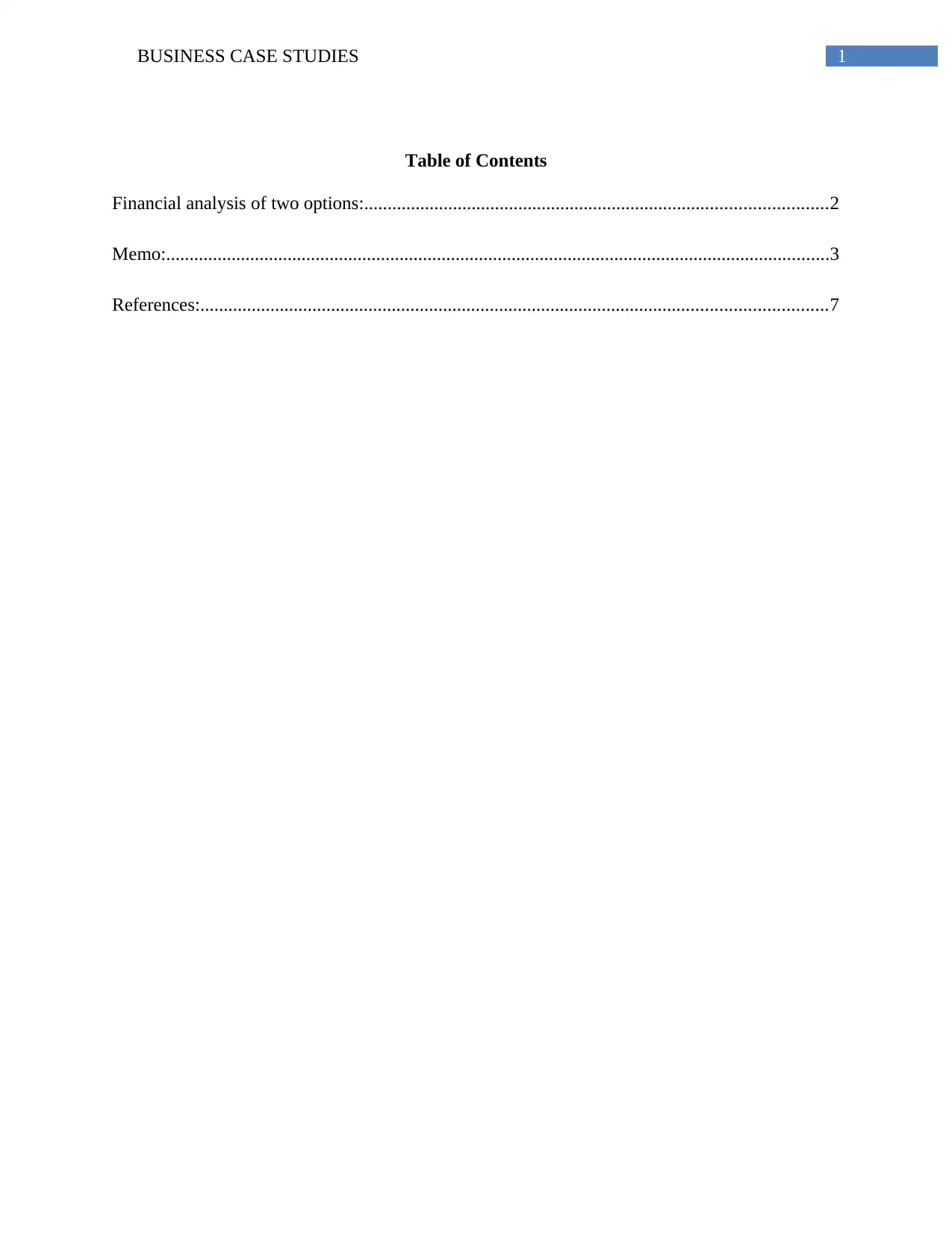
1BUSINESS CASE STUDIES
Table of Contents
Financial analysis of two options:...................................................................................................2
Memo:..............................................................................................................................................3
References:......................................................................................................................................7
Table of Contents
Financial analysis of two options:...................................................................................................2
Memo:..............................................................................................................................................3
References:......................................................................................................................................7
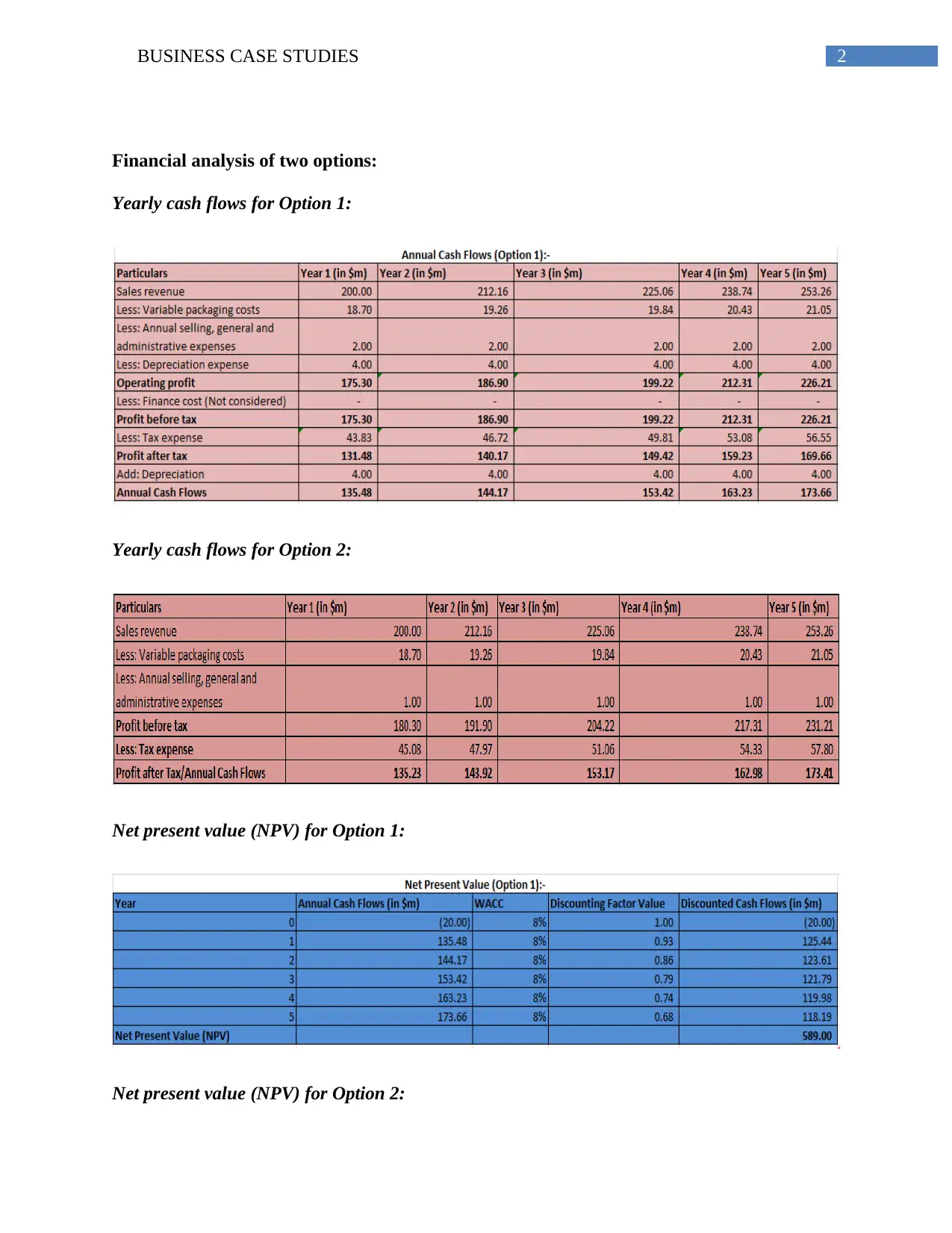
2BUSINESS CASE STUDIES
Financial analysis of two options:
Yearly cash flows for Option 1:
Yearly cash flows for Option 2:
Net present value (NPV) for Option 1:
Net present value (NPV) for Option 2:
Financial analysis of two options:
Yearly cash flows for Option 1:
Yearly cash flows for Option 2:
Net present value (NPV) for Option 1:
Net present value (NPV) for Option 2:
⊘ This is a preview!⊘
Do you want full access?
Subscribe today to unlock all pages.

Trusted by 1+ million students worldwide
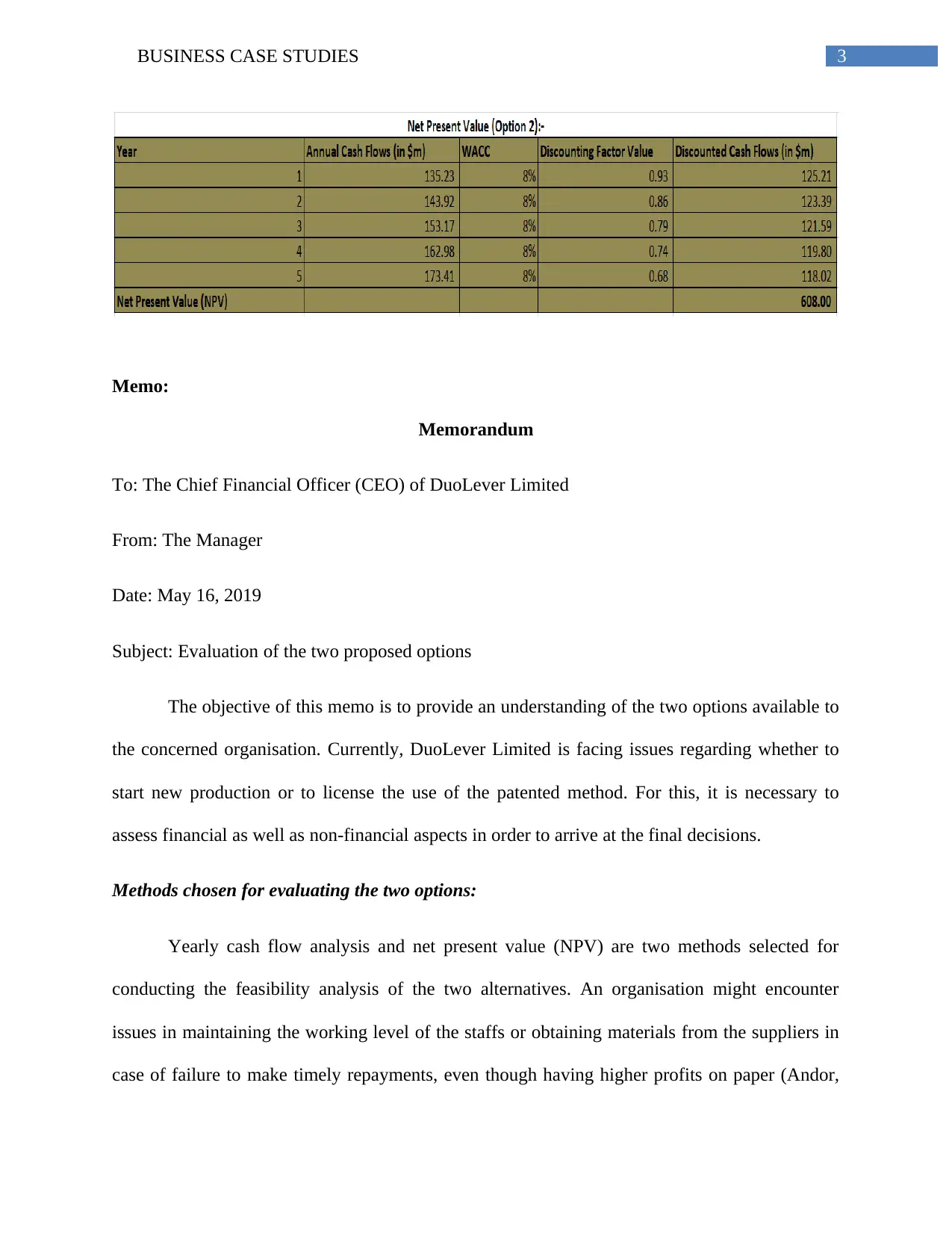
3BUSINESS CASE STUDIES
Memo:
Memorandum
To: The Chief Financial Officer (CEO) of DuoLever Limited
From: The Manager
Date: May 16, 2019
Subject: Evaluation of the two proposed options
The objective of this memo is to provide an understanding of the two options available to
the concerned organisation. Currently, DuoLever Limited is facing issues regarding whether to
start new production or to license the use of the patented method. For this, it is necessary to
assess financial as well as non-financial aspects in order to arrive at the final decisions.
Methods chosen for evaluating the two options:
Yearly cash flow analysis and net present value (NPV) are two methods selected for
conducting the feasibility analysis of the two alternatives. An organisation might encounter
issues in maintaining the working level of the staffs or obtaining materials from the suppliers in
case of failure to make timely repayments, even though having higher profits on paper (Andor,
Memo:
Memorandum
To: The Chief Financial Officer (CEO) of DuoLever Limited
From: The Manager
Date: May 16, 2019
Subject: Evaluation of the two proposed options
The objective of this memo is to provide an understanding of the two options available to
the concerned organisation. Currently, DuoLever Limited is facing issues regarding whether to
start new production or to license the use of the patented method. For this, it is necessary to
assess financial as well as non-financial aspects in order to arrive at the final decisions.
Methods chosen for evaluating the two options:
Yearly cash flow analysis and net present value (NPV) are two methods selected for
conducting the feasibility analysis of the two alternatives. An organisation might encounter
issues in maintaining the working level of the staffs or obtaining materials from the suppliers in
case of failure to make timely repayments, even though having higher profits on paper (Andor,
Paraphrase This Document
Need a fresh take? Get an instant paraphrase of this document with our AI Paraphraser
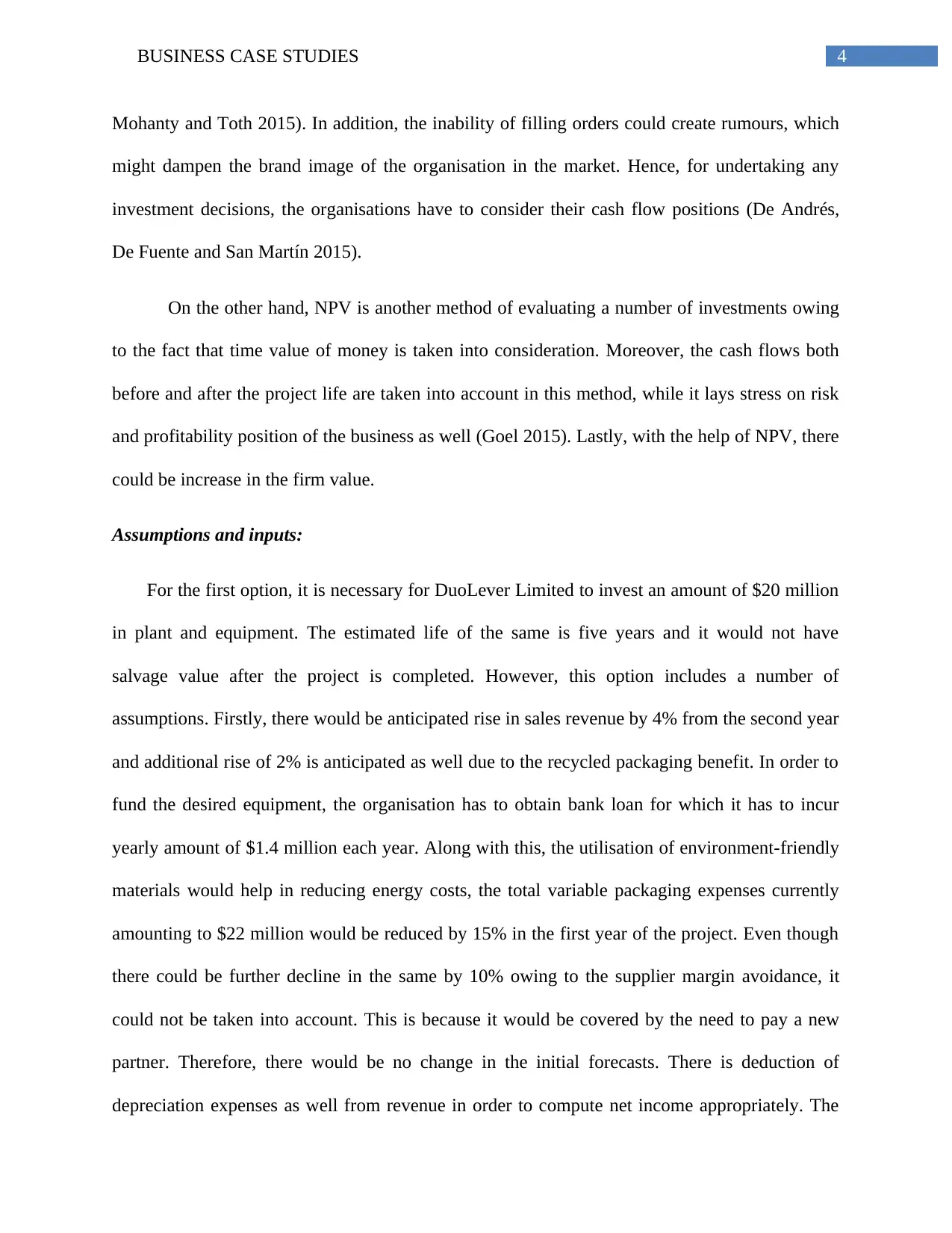
4BUSINESS CASE STUDIES
Mohanty and Toth 2015). In addition, the inability of filling orders could create rumours, which
might dampen the brand image of the organisation in the market. Hence, for undertaking any
investment decisions, the organisations have to consider their cash flow positions (De Andrés,
De Fuente and San Martín 2015).
On the other hand, NPV is another method of evaluating a number of investments owing
to the fact that time value of money is taken into consideration. Moreover, the cash flows both
before and after the project life are taken into account in this method, while it lays stress on risk
and profitability position of the business as well (Goel 2015). Lastly, with the help of NPV, there
could be increase in the firm value.
Assumptions and inputs:
For the first option, it is necessary for DuoLever Limited to invest an amount of $20 million
in plant and equipment. The estimated life of the same is five years and it would not have
salvage value after the project is completed. However, this option includes a number of
assumptions. Firstly, there would be anticipated rise in sales revenue by 4% from the second year
and additional rise of 2% is anticipated as well due to the recycled packaging benefit. In order to
fund the desired equipment, the organisation has to obtain bank loan for which it has to incur
yearly amount of $1.4 million each year. Along with this, the utilisation of environment-friendly
materials would help in reducing energy costs, the total variable packaging expenses currently
amounting to $22 million would be reduced by 15% in the first year of the project. Even though
there could be further decline in the same by 10% owing to the supplier margin avoidance, it
could not be taken into account. This is because it would be covered by the need to pay a new
partner. Therefore, there would be no change in the initial forecasts. There is deduction of
depreciation expenses as well from revenue in order to compute net income appropriately. The
Mohanty and Toth 2015). In addition, the inability of filling orders could create rumours, which
might dampen the brand image of the organisation in the market. Hence, for undertaking any
investment decisions, the organisations have to consider their cash flow positions (De Andrés,
De Fuente and San Martín 2015).
On the other hand, NPV is another method of evaluating a number of investments owing
to the fact that time value of money is taken into consideration. Moreover, the cash flows both
before and after the project life are taken into account in this method, while it lays stress on risk
and profitability position of the business as well (Goel 2015). Lastly, with the help of NPV, there
could be increase in the firm value.
Assumptions and inputs:
For the first option, it is necessary for DuoLever Limited to invest an amount of $20 million
in plant and equipment. The estimated life of the same is five years and it would not have
salvage value after the project is completed. However, this option includes a number of
assumptions. Firstly, there would be anticipated rise in sales revenue by 4% from the second year
and additional rise of 2% is anticipated as well due to the recycled packaging benefit. In order to
fund the desired equipment, the organisation has to obtain bank loan for which it has to incur
yearly amount of $1.4 million each year. Along with this, the utilisation of environment-friendly
materials would help in reducing energy costs, the total variable packaging expenses currently
amounting to $22 million would be reduced by 15% in the first year of the project. Even though
there could be further decline in the same by 10% owing to the supplier margin avoidance, it
could not be taken into account. This is because it would be covered by the need to pay a new
partner. Therefore, there would be no change in the initial forecasts. There is deduction of
depreciation expenses as well from revenue in order to compute net income appropriately. The
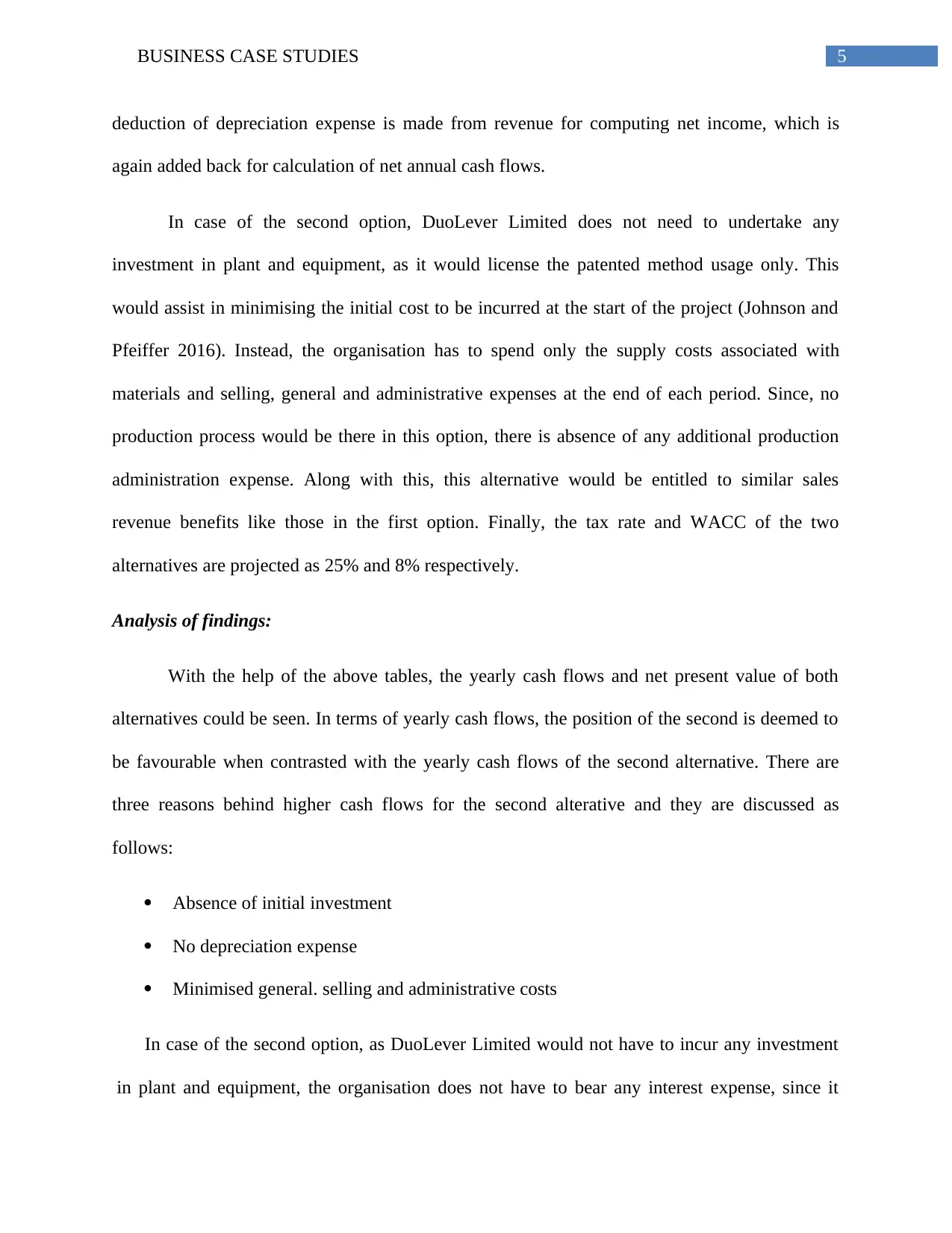
5BUSINESS CASE STUDIES
deduction of depreciation expense is made from revenue for computing net income, which is
again added back for calculation of net annual cash flows.
In case of the second option, DuoLever Limited does not need to undertake any
investment in plant and equipment, as it would license the patented method usage only. This
would assist in minimising the initial cost to be incurred at the start of the project (Johnson and
Pfeiffer 2016). Instead, the organisation has to spend only the supply costs associated with
materials and selling, general and administrative expenses at the end of each period. Since, no
production process would be there in this option, there is absence of any additional production
administration expense. Along with this, this alternative would be entitled to similar sales
revenue benefits like those in the first option. Finally, the tax rate and WACC of the two
alternatives are projected as 25% and 8% respectively.
Analysis of findings:
With the help of the above tables, the yearly cash flows and net present value of both
alternatives could be seen. In terms of yearly cash flows, the position of the second is deemed to
be favourable when contrasted with the yearly cash flows of the second alternative. There are
three reasons behind higher cash flows for the second alterative and they are discussed as
follows:
Absence of initial investment
No depreciation expense
Minimised general. selling and administrative costs
In case of the second option, as DuoLever Limited would not have to incur any investment
in plant and equipment, the organisation does not have to bear any interest expense, since it
deduction of depreciation expense is made from revenue for computing net income, which is
again added back for calculation of net annual cash flows.
In case of the second option, DuoLever Limited does not need to undertake any
investment in plant and equipment, as it would license the patented method usage only. This
would assist in minimising the initial cost to be incurred at the start of the project (Johnson and
Pfeiffer 2016). Instead, the organisation has to spend only the supply costs associated with
materials and selling, general and administrative expenses at the end of each period. Since, no
production process would be there in this option, there is absence of any additional production
administration expense. Along with this, this alternative would be entitled to similar sales
revenue benefits like those in the first option. Finally, the tax rate and WACC of the two
alternatives are projected as 25% and 8% respectively.
Analysis of findings:
With the help of the above tables, the yearly cash flows and net present value of both
alternatives could be seen. In terms of yearly cash flows, the position of the second is deemed to
be favourable when contrasted with the yearly cash flows of the second alternative. There are
three reasons behind higher cash flows for the second alterative and they are discussed as
follows:
Absence of initial investment
No depreciation expense
Minimised general. selling and administrative costs
In case of the second option, as DuoLever Limited would not have to incur any investment
in plant and equipment, the organisation does not have to bear any interest expense, since it
⊘ This is a preview!⊘
Do you want full access?
Subscribe today to unlock all pages.

Trusted by 1+ million students worldwide
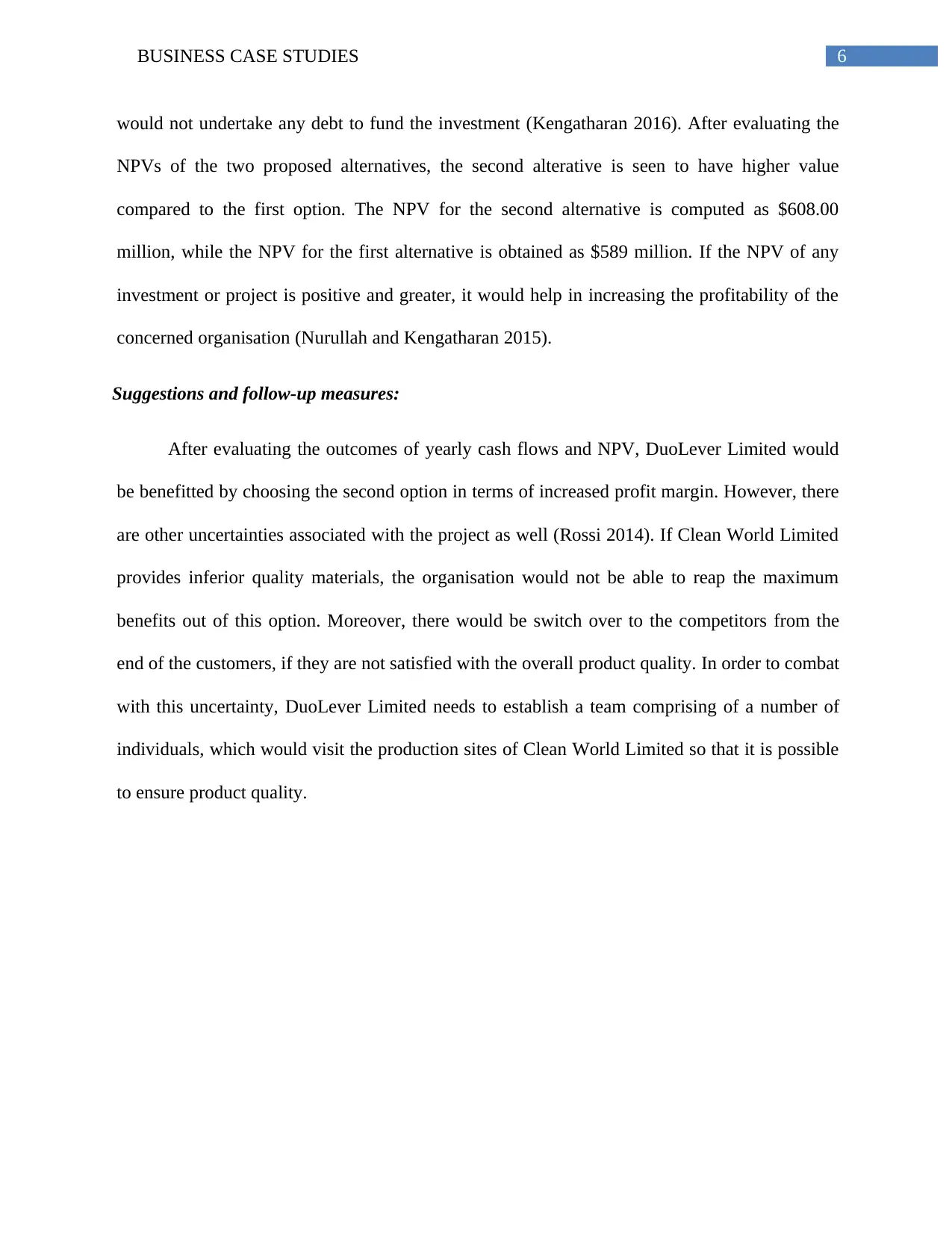
6BUSINESS CASE STUDIES
would not undertake any debt to fund the investment (Kengatharan 2016). After evaluating the
NPVs of the two proposed alternatives, the second alterative is seen to have higher value
compared to the first option. The NPV for the second alternative is computed as $608.00
million, while the NPV for the first alternative is obtained as $589 million. If the NPV of any
investment or project is positive and greater, it would help in increasing the profitability of the
concerned organisation (Nurullah and Kengatharan 2015).
Suggestions and follow-up measures:
After evaluating the outcomes of yearly cash flows and NPV, DuoLever Limited would
be benefitted by choosing the second option in terms of increased profit margin. However, there
are other uncertainties associated with the project as well (Rossi 2014). If Clean World Limited
provides inferior quality materials, the organisation would not be able to reap the maximum
benefits out of this option. Moreover, there would be switch over to the competitors from the
end of the customers, if they are not satisfied with the overall product quality. In order to combat
with this uncertainty, DuoLever Limited needs to establish a team comprising of a number of
individuals, which would visit the production sites of Clean World Limited so that it is possible
to ensure product quality.
would not undertake any debt to fund the investment (Kengatharan 2016). After evaluating the
NPVs of the two proposed alternatives, the second alterative is seen to have higher value
compared to the first option. The NPV for the second alternative is computed as $608.00
million, while the NPV for the first alternative is obtained as $589 million. If the NPV of any
investment or project is positive and greater, it would help in increasing the profitability of the
concerned organisation (Nurullah and Kengatharan 2015).
Suggestions and follow-up measures:
After evaluating the outcomes of yearly cash flows and NPV, DuoLever Limited would
be benefitted by choosing the second option in terms of increased profit margin. However, there
are other uncertainties associated with the project as well (Rossi 2014). If Clean World Limited
provides inferior quality materials, the organisation would not be able to reap the maximum
benefits out of this option. Moreover, there would be switch over to the competitors from the
end of the customers, if they are not satisfied with the overall product quality. In order to combat
with this uncertainty, DuoLever Limited needs to establish a team comprising of a number of
individuals, which would visit the production sites of Clean World Limited so that it is possible
to ensure product quality.
Paraphrase This Document
Need a fresh take? Get an instant paraphrase of this document with our AI Paraphraser
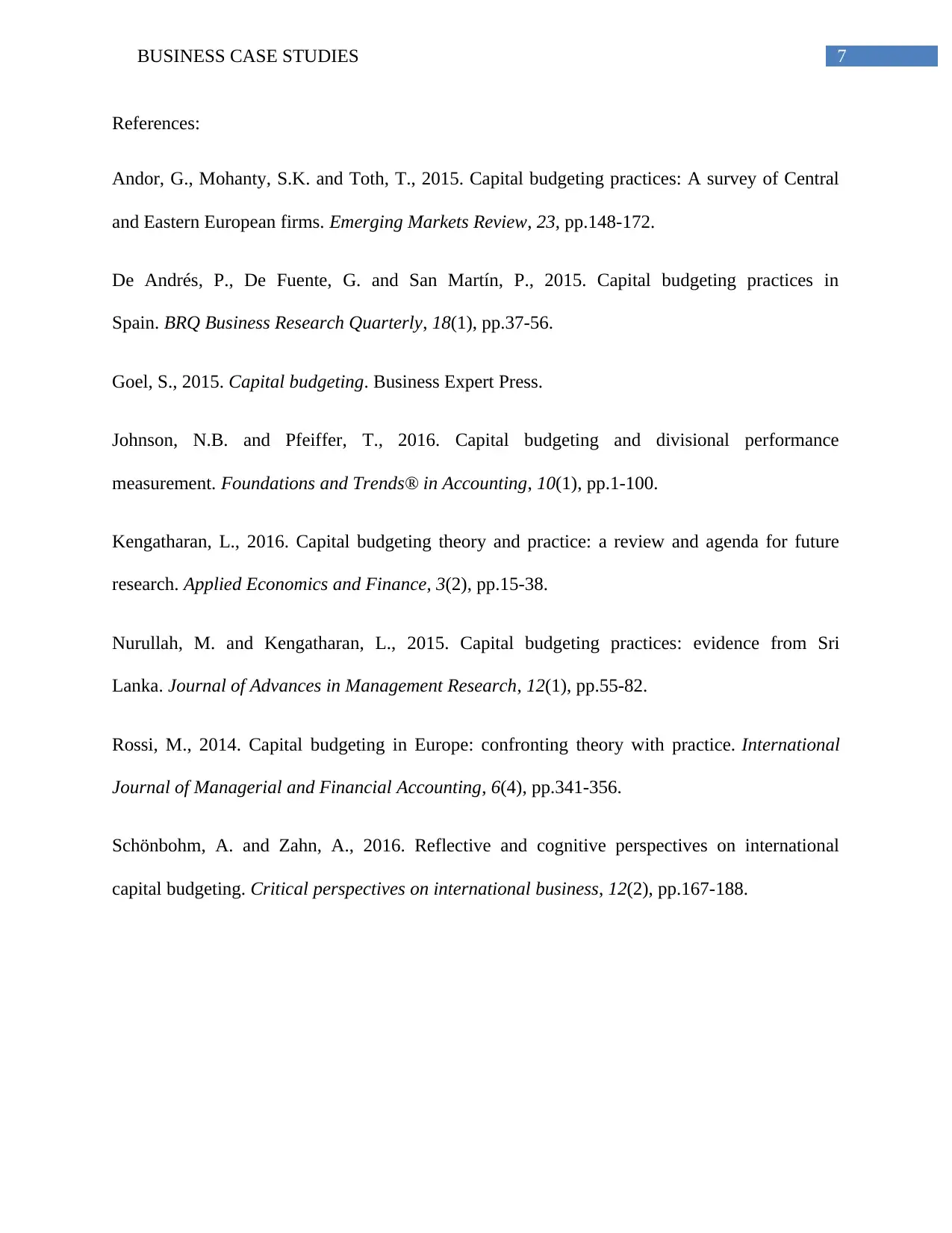
7BUSINESS CASE STUDIES
References:
Andor, G., Mohanty, S.K. and Toth, T., 2015. Capital budgeting practices: A survey of Central
and Eastern European firms. Emerging Markets Review, 23, pp.148-172.
De Andrés, P., De Fuente, G. and San Martín, P., 2015. Capital budgeting practices in
Spain. BRQ Business Research Quarterly, 18(1), pp.37-56.
Goel, S., 2015. Capital budgeting. Business Expert Press.
Johnson, N.B. and Pfeiffer, T., 2016. Capital budgeting and divisional performance
measurement. Foundations and Trends® in Accounting, 10(1), pp.1-100.
Kengatharan, L., 2016. Capital budgeting theory and practice: a review and agenda for future
research. Applied Economics and Finance, 3(2), pp.15-38.
Nurullah, M. and Kengatharan, L., 2015. Capital budgeting practices: evidence from Sri
Lanka. Journal of Advances in Management Research, 12(1), pp.55-82.
Rossi, M., 2014. Capital budgeting in Europe: confronting theory with practice. International
Journal of Managerial and Financial Accounting, 6(4), pp.341-356.
Schönbohm, A. and Zahn, A., 2016. Reflective and cognitive perspectives on international
capital budgeting. Critical perspectives on international business, 12(2), pp.167-188.
References:
Andor, G., Mohanty, S.K. and Toth, T., 2015. Capital budgeting practices: A survey of Central
and Eastern European firms. Emerging Markets Review, 23, pp.148-172.
De Andrés, P., De Fuente, G. and San Martín, P., 2015. Capital budgeting practices in
Spain. BRQ Business Research Quarterly, 18(1), pp.37-56.
Goel, S., 2015. Capital budgeting. Business Expert Press.
Johnson, N.B. and Pfeiffer, T., 2016. Capital budgeting and divisional performance
measurement. Foundations and Trends® in Accounting, 10(1), pp.1-100.
Kengatharan, L., 2016. Capital budgeting theory and practice: a review and agenda for future
research. Applied Economics and Finance, 3(2), pp.15-38.
Nurullah, M. and Kengatharan, L., 2015. Capital budgeting practices: evidence from Sri
Lanka. Journal of Advances in Management Research, 12(1), pp.55-82.
Rossi, M., 2014. Capital budgeting in Europe: confronting theory with practice. International
Journal of Managerial and Financial Accounting, 6(4), pp.341-356.
Schönbohm, A. and Zahn, A., 2016. Reflective and cognitive perspectives on international
capital budgeting. Critical perspectives on international business, 12(2), pp.167-188.
1 out of 8
Related Documents
Your All-in-One AI-Powered Toolkit for Academic Success.
+13062052269
info@desklib.com
Available 24*7 on WhatsApp / Email
![[object Object]](/_next/static/media/star-bottom.7253800d.svg)
Unlock your academic potential
Copyright © 2020–2025 A2Z Services. All Rights Reserved. Developed and managed by ZUCOL.





